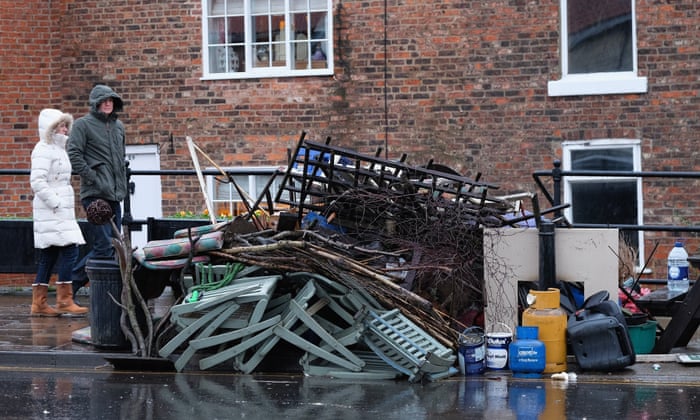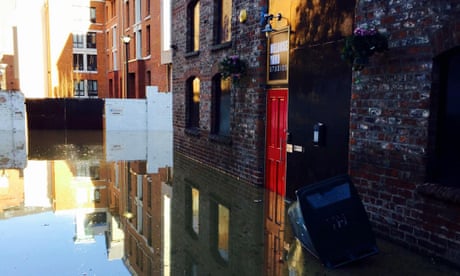Homeowners count the cost as floods force prices to plummet
01-03-2016
Damage caused to homes by Storm Frank 
Damage caused to homes by Storm Frank. Photograph: Ian Forsyth/Getty Images
Miles Brignall and Rupert Jones
People trying to sell their properties in flood-hit parts of north-west England have begun dramatically dropping their prices amid fears that houses in some roads have become virtually unsellable.
Large homes in and around the Warwick Road area of Carlisle, which in December 2015 experienced its second major flooding episode in a decade, have started to appear on the market for only 60% of their November values – leaving some people wondering whether they will ever be able to move house.

Broken dreams, sodden homes and businesses – the flood victims feeling shortchanged by insurers
After serious flooding elsewhere, house prices have generally recovered within a few years, according to estate agents in affected areas. This is particularly the case in national parks or other locations where there is strong demand for second and holiday homes.
Tewkesbury in Gloucestershire was hit by severe floods in 2007 but while prices took an initial dip, average property values in the town soon returned. It was a similar story in Cockermouth, Cumbria, which was devastated by floods in November 2009.
The deluge brought by Storm Desmond flooded 5,000 homes in Cumbria and Lancashire – but this time the effect on house prices could be much longer lasting, say some agents.
Simon Brown, a valuer at one of Carlisle’s oldest estate agents, Tiffen & Co, said he did not expect any houses in the affected roads to sell soon unless they were offered at a large discount.
“It had been a decade since the last big floods and prices had pretty much recovered. I’m not saying people had been hoodwinked, but they believed the flood defence work had been carried out and that the properties were safe. Now that it has happened again, I can’t see people being keen to buy in these roads again for a good long time, if ever,” he said.
Brown described how a large Victorian house that would have sold for more than £270,000 a month ago had just been put on the market for £170,000 in its flood-damaged state by an owner who could not face going through the drying for a second time.
“Most outsiders to the city would be amazed at the resilience that the residents have shown, and the way that the community has rallied round to help each other,” he said. “However, the people in the worst affected roads look completely snookered. You can always sell a home if the price is cheap enough, but there must be a growing fear that those in the affected streets will never see their pre-flood values ever again.”
In Cockermouth, flooded in 2009 and again in December, it has been a similar story, according to Diane Clark of estate agent Grisdales.
“Residents were told that the flood defences would save them, but now we can’t say that any more, and some people have had enough. I had a woman come in today to say she’s going to rent out her flooded home as she can’t face going through it all again. She’s lucky she’s in a position to buy another home further up the hill. The others who have also been badly flooded for a second time won’t be going anywhere soon.”
Revealed: how Tory cuts are wrecking UK flood defences
Despite that, Clark said she had sold a 50% shared-ownership property, that recently saw its garage and utility room flooded, for its full £80,000 asking price.
“Cockermouth is a place where people want to live. It’s a pretty town on the edge of the national park, and it comes at a huge discount [compared with] Keswick, 13 miles away. You have to feel for those in Gote Road, though. Who is going to buy a home that has been flooded twice in such a short space of time?” she said.
After the December floods, the MP for Workington in Cumbria, Sue Hayman, warned that problems with obtaining affordable insurance meant that “we’re likely to end up with streets of unsellable houses and empty shops”.
The Cumbrian town of Kendal was submerged in up to five feet of water by Storm Desmond. “It’s kind of something we’re just used to,” said Clare Hoban, residential property manager at agents Thomson Hayton Winkley. She said there were certain properties that flooded this time that had not been hit before, where the owners might potentially struggle to sell, but that had to be balanced against the fact that there was a shortage of properties in the area.
However, last month’s events have already had an impact on the Kendal housing market. One property that was on sale with the firm was flooded out and has now been taken off the market, and in the case of another, a sale was agreed but the buyers – from outside the area – have now pulled out, citing the Desmond deluge. “That house did not flood and will never flood – it’s too high up,” said Hoban.
The floods in York have been the worst in the city since 2000, though Ben Hudson, director of agents Hudson Moody, suggested that the effect on property values might be limited. “We have seen this before, and from my experience what has surprised me is how little the fact the properties have flooded has affected values once the initial impact has faded in people’s memories,” he said.
Unaffordable country: where can you afford to buy a house?
“Obviously if you are trying to sell a property which has only just flooded, it will make the job more difficult, but I estimate the initial drop in value is probably no more than 10% – and this recovered to virtually nothing within 12 months in 2000.”
Homeowners living in affected areas may want to take heart from the fact that a major 2009 study carried out for the Royal Institution of Chartered Surveyors found that flooding “has only a temporary impact on property values” and that after three years prices had returned to their normal market levels. A team of researchers looked at 11 locations that were flooded in 2000 (plus two that narrowly avoided being submerged), including Shrewsbury; Barlby, North Yorkshire; Mold, Flintshire; and Southsea, Hampshire.
The study found that for many towns that suffered in the 2000 floods, the prices of homes on the floodplain grew at the same rate as those in the surrounding areas.
“For the small minority of locations where a price dip was observed, the effect was temporary; prices recovered within three years at the most, often more quickly,” it stated, adding: “Memories are short - flood risk is not top of mind for most buyers most of the time.”

